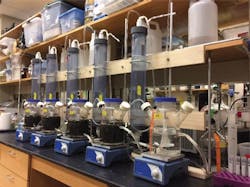About the author:
Jody Barksdale is senior vice president of Gresham, Smith and Partners. Barksdale can be reached at [email protected].
Cities increasingly are looking for ways to reduce operating costs, bring in additional sources of revenue, meet stringent regulatory requirements, and enhance resiliency and sustainability. Traditionally, U.S. wastewater treatment facilities have looked to anaerobic digestion—where wastewater solids are processed or “digested” by microorganisms at relatively high temperatures (greater than 95ºF)—to produce biogas; this also reduces the volume of sludge. The biogas produced by anaerobic digestion can be used to offset energy consumption at a wastewater treatment facility and be a potential source of revenue.
However, there is a limit to how much energy can be produced from municipal wastewater solids alone. That is why many utilities are embracing the potential of co-digestion, which allows municipalities to bring in outside high-strength waste (HSW), such as fats, oils and grease (FOG) wastes from industrial users or restaurants. The addition of HSW increases the volatile solids loading into the digester, which in turn can increase the amount of biogas that is produced. Essentially, wastewater treatment plants can supercharge waste to supplement the digestion process.
Cogeneration
Co-digestion often accompanies power production through cogeneration. Cogeneration, or combined heat and power (CHP), is the thermodynamically efficient use of a fuel source to simultaneously generate electricity and recover useful heat. The electricity and heat produced via cogeneration can be used to offset the cost of electricity and natural gas purchased from local utilities. For wastewater treatment facilities, biogas produced from anaerobic digestion provides fuel for an engine to generate onsite electricity and reusable heat, which often is subsequently used to heat the anaerobic digesters.
This has clear sustainability and resiliency impacts. It efficiently uses existing resources—such as biogas, a renewable fuel source—while hedging against issues such as rising energy costs and even the need for energy in case of the loss of power. More biogas created through co-digestion produces more electricity, improves heat capture opportunities and moves the facility closer to net-neutral energy usage. Additionally, co-digestion often can improve the digestion process to yield higher volatile solids reduction, improved nutrient balance and more effective use of the digester volume. This provides operational benefits by diverting waste from the sewer system and landfills while also providing revenue from tipping feeds. However, to realize these benefits, it is critical to choose the right HSWs.
Making the Best of HSWs
HSWs are available based on an area’s industry and often are the byproducts of food and beverage industries located there. Each HSW needs to be individually characterized and evaluated to uncover the benefits of different waste sources, so the chosen HSW streams can maximize biogas production and not upset biological processes. All potential HSWs should meet the following minimum requirements:
- No known toxic constituents such as heavy metals, extreme pH, sanitary chemicals or biocides.
- High potential biogas production based on methane production potential. Methane production generally is quantified by sample strength or chemical oxygen demand (COD), ultimate digestibility, and specific methane production.
- Prescreened and homogeneous waste that is free of trash, grit or other large particulates. Food and beverage processing byproducts are relatively free of debris. Others, such as solid food waste, can contain particulates of concern such as trash, utensils, etc., which could lead to maintenance or performance issues.
- Reliable quantity and supply from HSW producer. It is important to contract with HSW producers that are consistent and reliable rather than seasonal, and that can produce enough waste to make the relationship worthwhile.
- Proximity of HSW to treatment facility or easy accessibility for collection. Proximity, as well as reliable quantity and supply, are critical for cost-effectiveness, logistical soundness and long-term potential use.
- Beneficial diversion of HSW from sanitary sewer and/or landfills. HSW diversion can reduce collection system odors and impact on the sewer system, landfill footprint, and energy and chemicals required for treatment at the treatment facility.
Utilities should perform a bench-scale laboratory evaluation of the co-digestion of HSW streams and municipal sludge mixtures to determine the optimal HSW sources and mix for expected biogas production.
Laboratory Evaluation
The city of Atlanta is pursuing several energy conservation and resource recovery measures to advance its sustainability and enhance system resiliency. One of its main efforts is a drive toward net-neutral energy at its water reclamation centers (WRCs). As part of its initiatives, Atlanta’s Department of Watershed Management commissioned a CHP generation unit for the R.M. Clayton WRC. Subsequently, Atlanta determined it would like to evaluate capabilities to implement both co-digestion and cogeneration at another WRC, the 44-million-gal-per-day (mgd) Utoy Creek WRC. It is working with Gresham, Smith and Partners as part of a joint venture with Black & Veatch and Dr. Spyros Pavlostathis from the School of Civil and Environmental Engineering at the Georgia Institute of Technology to evaluate options for the facility. A study identified sources of HSW and assessed the feasibility of co-digestion of different HSW streams that would be used at Utoy Creek to generate the additional methane required. Successful bench-scale laboratory evaluations include waste characterization, ultimate digestibility and biodegradability tests, and bench-scale digestion runs on individual and combined wastes.

